
The Bergisches Land is a low mountain range in the state of North Rhine-Westphalia, Germany, east of the Rhine and south of the Ruhr. The landscape is shaped by woods, meadows, rivers and creeks and contains over twenty artificial lakes. Wuppertal is the biggest town, while the southern part has economic and socio-cultural ties to Cologne. Wuppertal and the neighbouring cities of Remscheid and Solingen form the Bergisches Städtedreieck.

Limburgish, also called Limburgan, Limburgian, or Limburgic, is a West Germanic language spoken in the Dutch and Belgian provinces of Limburg and in the neighbouring regions of Germany.
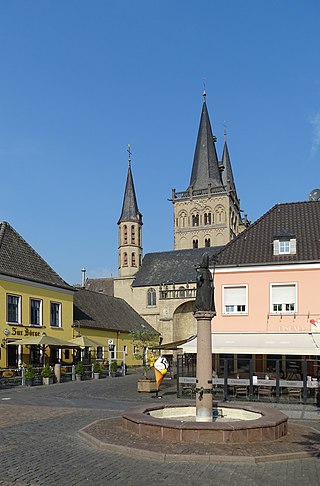
Xanten is a town in the state of North Rhine-Westphalia, Germany. It is located in the district of Wesel.

Weeze Airport, less commonly known as Niederrhein Airport, is a minor international airport in the Lower Rhine region of Germany. It is used by Ryanair. The airport is situated 3.7 km (2.3 mi) southwest of the municipality of Weeze and 7 km (4.3 mi) northwest of Kevelaer, about 33 km (21 mi) southeast of the Dutch city of Nijmegen, and 48 km (30 mi) northwest of the German city of Duisburg. Between 2008 and 2013, this was one of Germany's fastest-growing airports; however, the airport handled only 1.23 million passengers in 2019, reflecting a decline in throughput triggered by Ryanair reducing its route network.

Geldern is a city in the federal German state of North Rhine-Westphalia. It is part of the district of Kleve, which is part of the Düsseldorf administrative region.

Weeze is a municipality in the Lower Rhine (Niederrhein) region, located in the northwestern part of North Rhine-Westphalia, specifically in the district of Kleve and the Düsseldorf region.
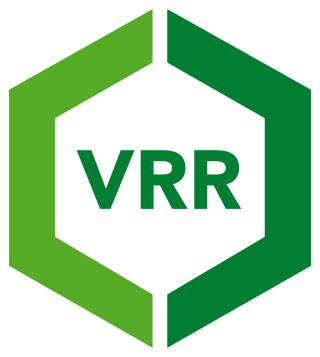
The Verkehrsverbund Rhein-Ruhr, abbreviated VRR, is a public transport association (Verkehrsverbund) in the German state of North Rhine-Westphalia. It covers most of the Ruhr area, as well as neighbouring parts of the Lower Rhine region, including Düsseldorf and thus large parts of the Rhine-Ruhr conurbation. It was founded on 1 January 1980, and is Europe’s largest body of such kind, covering an area of some 5,000 km2 (1,900 sq mi) with more than 7.8 million inhabitants, spanning as far as Dorsten in the north, Dortmund in the east, Langenfeld in the south, and Mönchengladbach and the Dutch border in the west.

Rees is a town in the district of Kleve in the state of North Rhine-Westphalia, Germany. It is located on the right bank of the Rhine, approximately 20 km east of Kleve. The population in 2005 was 22,559. Founded in 1228, Rees is the oldest town in the lower Rhine area.
Duisburg Hauptbahnhof is a railway station in the city of Duisburg in western Germany. It is situated at the meeting point of many important national and international railway lines in the Northwestern Ruhr valley.
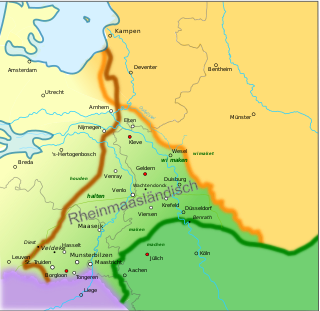
In linguistics, Meuse-Rhenish is a term with several meanings, used both in literary criticism and dialectology.

The Oberliga Niederrhein is a German amateur football division administered by the Football Association of the Lower Rhine, one of the 21 German state football associations. Being the top flight of the Lower Rhine state association, the Oberliga is currently a level 5 division of the German football league system.

The Gauliga Niederrhein was the highest football league in the northern part of the Prussian Rhine Province from 1933 to 1945. Shortly after the formation of the league, the Nazis reorganised the administrative regions in Germany, and the GaueEssen and Düsseldorf replaced the Prussian province in the Lower Rhein region.
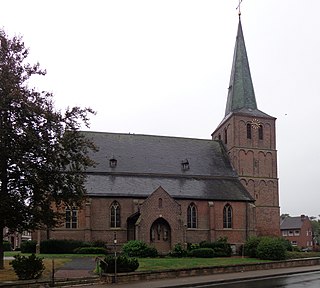
Kapellen an der Fleuth is a village of about 2600 people in northwest Germany near the border of the Netherlands. Since 1969 the village has been a part of the city of Geldern. Kapellen lies in the Niederrhein in the northwest part of German Federal State of Nordrhein-Westfalen. The village is approximately 72 kilometres from Düsseldorf, 16 km (10 mi) from the Rhine River at Xanten and 180 km (112 mi) from Amsterdam, Netherlands.
Abellio Deutschland is a public transit operator in Germany operating bus and rail networks. Headquartered in Berlin, it is a subsidiary of the Dutch state-owned Abellio.

The Duisburg-Ruhrort–Mönchengladbach railway is a historically significant, but now partly abandoned line in the German state of North Rhine-Westphalia. The line was built by the Ruhrort-Crefeld District Gladbach Railway Company, founded in 1847, and is one of the oldest lines in Germany, opened in 1849 and 1851.
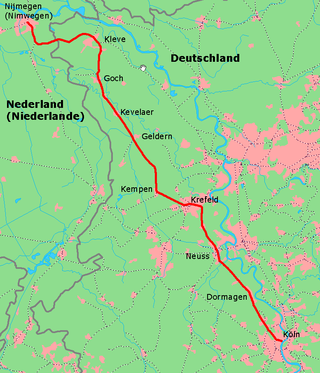
The Left Lower Rhine line is a main line on the left (western) bank of the Rhine in the lower Rhine region of the German state of North Rhine-Westphalia, running from Cologne to Cleves (Kleve) and formerly via Kranenburg to Nijmegen in the Netherlands. The Cologne–Krefeld section of the line was opened by the Cöln-Crefeld Railway Company in 1855 and is one of the oldest lines in Germany.
The Spyck–Welle train ferry was a train ferry on the Rhine between Spyck on the left (southern) bank and Welle on the right bank in the lower Rhine region of the German state of North Rhine-Westphalia. It was established in 1865 by the Rhenish Railway Company on the Lower Left Rhine line from Cologne to Neuss, Krefeld, Cleves, Elten, Zevenaar and the Dutch North Sea ports.

Kleve is a railway station in the town of Kleve, North Rhine Westphalia, Germany. The station opened on 5 March 1863 on the Lower Left Rhine Railway. The train services are operated by NordWestBahn.

The County of Moers was a historical princely territory on the left bank of the Lower Rhine that included the towns of Moers and Krefeld as well as the surrounding villages and regions.





















